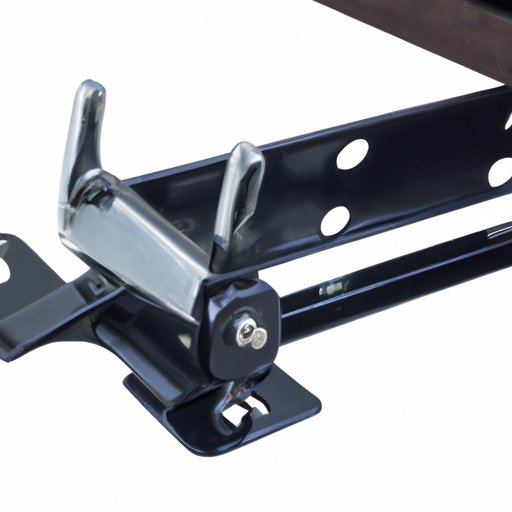
Introduction
If you’re new to towing, it can be overwhelming to figure out which equipment you need for your RV. One essential piece is the weight distributing hitch. This article aims to provide an informative guide to weight distributing hitches, how they work, their benefits and drawbacks, and how to install and maintain them.
An Informational Guide to Weight Distributing Hitches
Weight distributing hitches are designed to evenly distribute the weight of your RV onto your towing vehicle’s axles and wheels. This makes towing safer and more comfortable for you, your passengers and your vehicle. They work by redistributing the downward force from the tongue of the trailer to the rest of the vehicle. They also help reduce the strain on your rear axle and ensure that your vehicle remains level during towing, which is essential for proper handling.
One of the main benefits of a weight distributing hitch is the increased stability during towing, particularly at higher speeds or when encountering crosswinds or other disturbances. However, they do have some drawbacks, such as reducing the amount of weight you can carry and making it more difficult to back up your rig. It’s crucial to install your weight distributing hitch correctly to ensure that it works as intended. Whenever you’re installing a new hitch, make sure to read the manufacturer’s instructions carefully and follow each step in the correct order to avoid making any mistakes.
A common mistake when installing weight distributing hitches is to not pay attention to the hitch’s weight capacity, which can lead to instability during towing. Also, ensure that your weight distributing hitch is properly adjusted before heading out on your trip – otherwise, it won’t work effectively, and you could be putting yourself and others at risk.
A Comparative Guide to Weight Distributing Hitches and Sway Control Systems
Sway control systems are designed to counteract the swaying that can sometimes occur when towing an RV, particularly during high-speed maneuvers or in windy conditions. While some weight distributing hitches come with built-in sway control systems, others require a separate system. Determining which option is right for you and your towing methods can take some consideration.
Various types of weight distributing hitches and sway control systems are available, including friction sway control, dual-cam sway control, and electronic sway control, to name a few. Ultimately, you may need to use a weight distributing hitch and sway control system together to ensure maximum safety and comfort during your travels.
A Buyer’s Guide to Weight Distributing Hitches
When choosing a weight distributing hitch, it’s essential to consider all the options and pick the one that’s best suited for your RV type and towing needs. Hitch weight capacity, hitch ball size, and the type of hitch shank are crucial factors to keep in mind. There are different weight distribution hitches available, with each catering to specific RV weights and sizes.
Purchasing a weight distributing hitch that has the correct weight distribution capacity is vital. This ensures that the weight is distributed evenly on both the trailer and your towing vehicle. Selecting the appropriate hitch ball size and type of hitch shank is important as they affect the hitch’s ability to connect to your trailer.
How to Maintain and Troubleshoot Weight Distributing Hitches
Like any piece of equipment, weight distributing hitches require periodic maintenance to remain in top condition. Some common issues that may arise include sway and noise when towing, inadequate weight distribution, and overloading the hitch or trailer. Regular inspection and maintenance can help detect these potential issues before they become serious problems.
Basic maintenance typically includes cleaning, lubrication, and keeping the hitch adjusted correctly. To make it last longer, properly store the hitch and avoid hitting it against obstacles or road bumps. Using your hitch in accordance with the manufacturer’s guidelines is the key to keeping it in good working condition.
A Technical Guide to Weight Distributing Hitches
The physics behind how weight distributing hitches work involve a combination of leverage, torque, and center of gravity. Properly installing them ensures they work as intended. When towing your RV, the hitch and trailer’s center of gravity should remain balanced to avoid any potential for instability or sway.
The role of leverage is used in weight distributing hitches to transfer weight from the rear of the trailer and tow vehicle towards the front. Torque is responsible for keeping the trailer level and restoring the weight balance to the front and rear of the vehicle. The center of gravity is an important factor when towing, and its correct position must be maintained to keep your vehicle level, especially with different weights of RV types.
Conclusion
Weight distributing hitches are an indispensable piece of equipment for anyone who tows an RV. Understanding how they work and how to use them properly can make your travels more comfortable, safer, and more enjoyable. Hopefully, this guide has provided you with valuable insights into weight distributing hitches and their mechanics, benefits and drawbacks, correct installation and maintenance methods, and which weight distribution capacity of the hitch should be used for which RV type.
Remember, always follow the manufacturer’s guidelines and recommendations when installing, using, and maintaining your weight distributing hitch, ensuring a safe and hassle-free journey.





